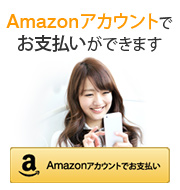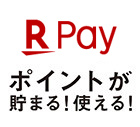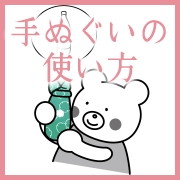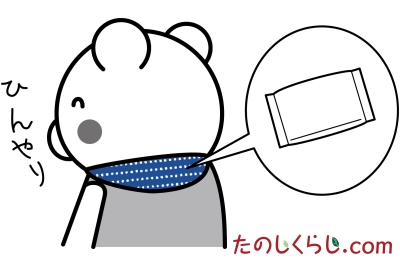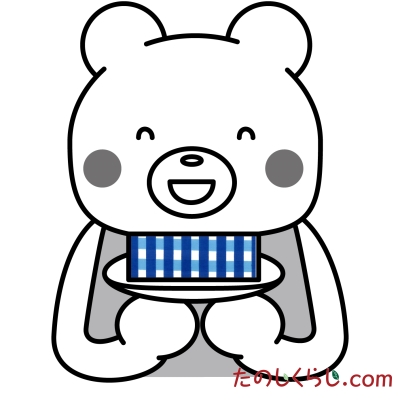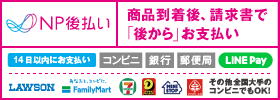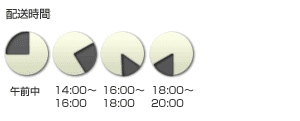|
|
|
|
|
お気に入り
-
日本の伝統工芸品
-
日本製の衣類
-
カタログギフト
人気ランキング
 |
刺子織信玄袋 日本製5,940円(税込)
|
 |
【送料無料】刺子織頭陀袋 濃紺 日本製11,000円(税込)
|
 |
【送料無料】本柿渋染頭陀袋 日本製15,400円(税込)
|
 |
さかえ屋のカステラ 詰め合わせ3品セット2,390円(税込)
|
 |
【送料無料】京念珠ブレスレット(桐箱入り)9,800円(税込)
|
【お買い物の参考に…】お客様の声を直筆でいただきました♪
カレンダー
| 今日 | |
| 定休日 |
なお、受付時間外・外出時などにいただいたお問い合わせにつきましては、お返事が翌営業日以降になることもございますのでご了承ください。
(お電話でのお問い合わせのときはメッセージを残していただけましたら、折り返しご連絡いたします)
返信がお客様に届かない場合に備え、お名前・お電話番号の記載もお願いいたします。
◆お問い合わせ先:
shop@tanoshikurashi.com
手ぬぐいの使い方 その十二 「ネッククーラー」 <12. Cold neck scarf>
手ぬぐいは歴史を遡ると、奈良~平安時代には使われていたと云われています。当時は布が貴重だったため身分の高い者しか手にできませんでしたが、鎌倉時代以降から庶民にも少しずつ普及し、日本国内で綿花栽培が発展した江戸時代から、木綿の織物とともに生活用品として庶民に欠かせない物になりました。 当時は、ガーゼや包帯などの役割から、現代のタオルや台拭や雑巾やハンカチなどの役割も担い、そのほかには縁起物としての贈答品や配り物としても使われ、本来の汗や水の吸水の目的だけでなく様々な用途の広がりをみせていきました。 ここでは、「手ぬぐいの使い方」として、現代での使い方をイラスト入りでご紹介していきます。 その十二は "ネッククーラー" です! 保冷剤を手ぬぐいで包んで首に巻くとネッククーラーに早変わり。ハチマキのように頭に巻いて、熱冷ましとしても使えます。 手軽でエコな手ぬぐいの "ネッククーラー" で、暑い夏を快適に過ごしましょう(^^) In Japanese history, the tenugui (Japanese towel) was originally used approximately between 700s and 1100s A.D. (Nara & Heian era in Japan). At that time, the tenugui was only available for people of high social status, because cloth was a valuable item. After the late 1100s (during the Kamakura era), the tenugui gradually became available to commoners. In the 1600s, when cotton farming developed, the tenugui, as well as cotton fabric, became a common item for people in Japan. Since then, tenugui usage has expanded from as a simple towel to absorb liquid to as a gauze bandage and a gift and giveaway item. Below are some examples of how to use the tenugui during modern times (with illustrations): <12. Cold neck scarf> A small ice pack wrapped in a tenugui makes an easy cold neck scarf which is very useful on a very hot day. It could be used to keep one’s forehead cool when you have a fever by wrapping it around the head. 手ぬぐいの使い方 その十一 「おしぼり」 <11. As an oshibori (wet towel)>
手ぬぐいは歴史を遡ると、奈良~平安時代には使われていたと云われています。当時は布が貴重だったため身分の高い者しか手にできませんでしたが、鎌倉時代以降から庶民にも少しずつ普及し、日本国内で綿花栽培が発展した江戸時代から、木綿の織物とともに生活用品として庶民に欠かせない物になりました。 当時は、ガーゼや包帯などの役割から、現代のタオルや台拭や雑巾やハンカチなどの役割も担い、そのほかには縁起物としての贈答品や配り物としても使われ、本来の汗や水の吸水の目的だけでなく様々な用途の広がりをみせていきました。 ここでは、「手ぬぐいの使い方」として、現代での使い方をイラスト入りでご紹介していきます。 その十一は "おしぼり" です! 洗ってもすぐに乾く手ぬぐいは、おしぼりとしても使えます。おしぼりの語源が、江戸時代の旅籠で玄関に用意された水桶と手ぬぐいから来ていると云われ、客が手ぬぐいを桶の水に浸してしぼり使ったことから、おしぼりと名がついたそうです。 使い捨ての物とは一味違った手ぬぐいの "おしぼり" で、身も心もリフレッシュ!(^^) In Japanese history, the tenugui (Japanese towel) was originally used approximately between 700s and 1100s A.D. (Nara & Heian era in Japan). At that time, the tenugui was only available for people of high social status, because cloth was a valuable item. After the late 1100s (during the Kamakura era), the tenugui gradually became available to commoners. In the 1600s, when cotton farming developed, the tenugui, as well as cotton fabric, became a common item for people in Japan. Since then, tenugui usage has expanded from as a simple towel to absorb liquid to as a gauze bandage and a gift and giveaway item. Below are some examples of how to use the tenugui during modern times (with illustrations): <11. As an oshibori (wet towel)> Because the tenugui dries quickly, it can be a great choice as an oshibori. The origin of the word oshibori comes from the Edo era (early 1600s - mid 1800s). When a traveler arrived at a tavern, the innkeep prepared a washpot filled with water and a tenugui at the entrance for the traveler. The traveler then soaked the tenugui in the water and used it after he/she squeezed the water off (shibori in Japanese) to make a wet towel, which was later called “oshibori”. 手ぬぐいの使い方 その十 「つつむ」 <10. Wrap a gift>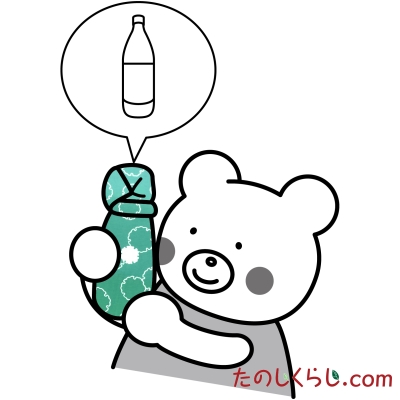 当時は、ガーゼや包帯などの役割から、現代のタオルや台拭や雑巾やハンカチなどの役割も担い、そのほかには縁起物としての贈答品や配り物としても使われ、本来の汗や水の吸水の目的だけでなく様々な用途の広がりをみせていきました。 ここでは、「手ぬぐいの使い方」として、現代での使い方をイラスト入りでご紹介していきます。 その十は "つつむ" です! 元々、手ぬぐいは贈答品や配り物としても使われてきましたが、別の品物を手ぬぐいでラッピングして差し上げるという使い方もできます。日本酒やワインなどを瓶包みすると格好よく、手ぬぐいはその後も使ってもらえるので、紙包装と違い無駄なゴミもでません。 手ぬぐいで "つつむ" と、貰い手も嬉しさアップ!(^^) In Japanese history, the tenugui (Japanese towel) was originally used approximately between 700s and 1100s A.D. (Nara & Heian era in Japan). At that time, the tenugui was only available for people of high social status, because cloth was a valuable item. After the late 1100s (during the Kamakura era), the tenugui gradually became available to commoners. In the 1600s, when cotton farming developed, the tenugui, as well as cotton fabric, became a common item for people in Japan. Since then, tenugui usage has expanded from as a simple towel to absorb liquid to as a gauze bandage and a gift and giveaway item. Below are some examples of how to use the tenugui during modern times (with illustrations): <10. Wrap a gift> Although tenugui was originally used as a gift and/or a giveaway item, it can also wrap a gift. A bottle of sake or wine wrapped with tenugui can be a great gift. Because the tenugui is reusable, it is also good for the environment. 手ぬぐいの使い方 その九 「枕カバー」 <9. As a pillow cover>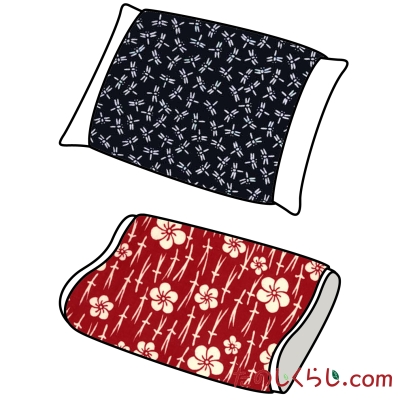 当時は、ガーゼや包帯などの役割から、現代のタオルや台拭や雑巾やハンカチなどの役割も担い、そのほかには縁起物としての贈答品や配り物としても使われ、本来の汗や水の吸水の目的だけでなく様々な用途の広がりをみせていきました。 ここでは、「手ぬぐいの使い方」として、現代での使い方をイラスト入りでご紹介していきます。 その九は "枕カバー" です! 肌触りの良い手ぬぐいは、どんな形の枕にもフィットします。枕に手ぬぐいを巻くだけなので取り替えも楽々。お手入れも簡単です。自宅用だけでなく、宿泊先のホテルや旅館の枕に手ぬぐいを巻いてもよいですね。 手ぬぐいの "枕カバー" で快眠です(^^) In Japanese history, the tenugui (Japanese towel) was originally used approximately between 700s and 1100s A.D. (Nara & Heian era in Japan). At that time, the tenugui was only available for people of high social status, because cloth was a valuable item. After the late 1100s (during the Kamakura era), the tenugui gradually became available to commoners. In the 1600s, when cotton farming developed, the tenugui, as well as cotton fabric, became a common item for people in Japan. Since then, tenugui usage has expanded from as a simple towel to absorb liquid to as a gauze bandage and a gift and giveaway item. Below are some examples of how to use the tenugui during modern times (with illustrations): <9. As a pillow cover> Tenugui can fit any shape pillows. Wrapping a pillow with a tenugui is very simple and easy to take off to wash. Travelling with a tenugui and use it as a pillow cover can be another way to use the tenugui. 手ぬぐいの使い方 その八 「台所」 <8. In the kitchen>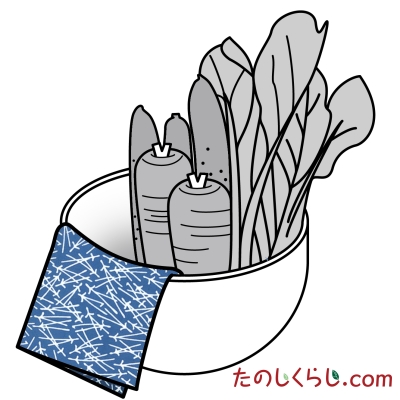 当時は、ガーゼや包帯などの役割から、現代のタオルや台拭や雑巾やハンカチなどの役割も担い、そのほかには縁起物としての贈答品や配り物としても使われ、本来の汗や水の吸水の目的だけでなく様々な用途の広がりをみせていきました。 ここでは、「手ぬぐいの使い方」として、現代での使い方をイラスト入りでご紹介していきます。 その八は "台所" です! 薄くて軽くてすぐ乾くので、手ぬぐき用や食器拭き用として手ぬぐいを台所に数枚置いておくと便利。ふきんや鍋敷き、お料理のホコリよけ等にも使えます。 手ぬぐいは "台所" の必需品です(^^) In Japanese history, the tenugui (Japanese towel) was originally used approximately between 700s and 1100s A.D. (Nara & Heian era in Japan). At that time, the tenugui was only available for people of high social status, because cloth was a valuable item. After the late 1100s (during the Kamakura era), the tenugui gradually became available to commoners. In the 1600s, when cotton farming developed, the tenugui, as well as cotton fabric, became a common item for people in Japan. Since then, tenugui usage has expanded from as a simple towel to absorb liquid to as a gauze bandage and a gift and giveaway item. Below are some examples of how to use the tenugui during modern times (with illustrations): <8. In the kitchen> Tenugui can be used not only to dry dishes and clean tables but also to wipe hands, cover meals, as well as a hot pad. 手ぬぐいの使い方 その七 「お弁当包み」 <7. Lunchbox cover>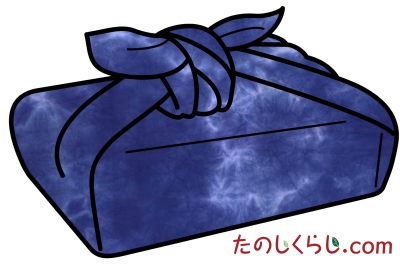 当時は、ガーゼや包帯などの役割から、現代のタオルや台拭や雑巾やハンカチなどの役割も担い、そのほかには縁起物としての贈答品や配り物としても使われ、本来の汗や水の吸水の目的だけでなく様々な用途の広がりをみせていきました。 ここでは、「手ぬぐいの使い方」として、現代での使い方をイラスト入りでご紹介していきます。 その七は "お弁当包み" です! 手ぬぐいでササッとお弁当箱を包むだけ。色柄豊富な手ぬぐいは使う柄によって雰囲気が変わるので、季節に合わせて柄を変えてみるのも楽しみのひとつ。 ランチタイムが楽しくなる "お弁当包み" です(^^) In Japanese history, the tenugui (Japanese towel) was originally used approximately between 700s and 1100s A.D. (Nara & Heian era in Japan). At that time, the tenugui was only available for people of high social status, because cloth was a valuable item. After the late 1100s (during the Kamakura era), the tenugui gradually became available to commoners. In the 1600s, when cotton farming developed, the tenugui, as well as cotton fabric, became a common item for people in Japan. Since then, tenugui usage has expanded from as a simple towel to absorb liquid to as a gauze bandage and a gift and giveaway item. Below are some examples of how to use the tenugui during modern times (with illustrations): <7. Lunchbox cover> Wrapping a lunch box with a tenugui gives an accent to a plain lunch box. Using different tenugui in different seasons could make lunch time fun. 手ぬぐいの使い方 その六 「足ふきマット」 <6. As a bathroom rug>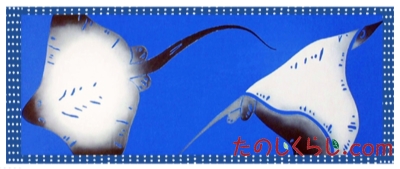 当時は、ガーゼや包帯などの役割から、現代のタオルや台拭や雑巾やハンカチなどの役割も担い、そのほかには縁起物としての贈答品や配り物としても使われ、本来の汗や水の吸水の目的だけでなく様々な用途の広がりをみせていきました。 ここでは、「手ぬぐいの使い方」として、現代での使い方をイラスト入りでご紹介していきます。 その六は "足ふきマット" です! 手ぬぐいを三重ぐらいに重ねただけでお風呂場の足ふきマットにもなります。手ぬぐいは乾きが早いので、お手入れもしやすいですね。手ぬぐいを二重にして、間にタオルを挟んでもグッド。 お風呂に "手ぬぐいの足ふきマット" です(^^) In Japanese history, the tenugui (Japanese towel) was originally used approximately between 700s and 1100s A.D. (Nara & Heian era in Japan). At that time, the tenugui was only available for people of high social status, because cloth was a valuable item. After the late 1100s (during the Kamakura era), the tenugui gradually became available to commoners. In the 1600s, when cotton farming developed, the tenugui, as well as cotton fabric, became a common item for people in Japan. Since then, tenugui usage has expanded from as a simple towel to absorb liquid to as a gauze bandage and a gift and giveaway item. Below are some examples of how to use the tenugui during modern times (with illustrations): <6. As a bathroom rug> A triple-folded tenugui can be a nice bathroom rug. It is easy to dry because of its thinness. Adding a towel between folded tenugui provides extra feet comfort. 手ぬぐいの使い方 その五 「カゴの目隠し」 <5. For a basket cover>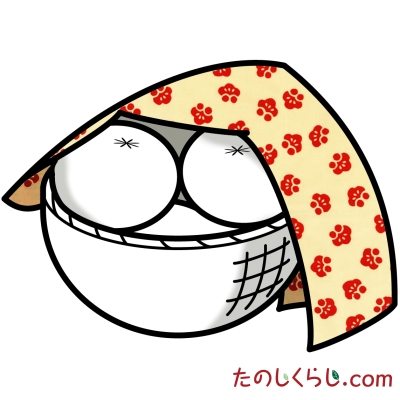 当時は、ガーゼや包帯などの役割から、現代のタオルや台拭や雑巾やハンカチなどの役割も担い、そのほかには縁起物としての贈答品や配り物としても使われ、本来の汗や水の吸水の目的だけでなく様々な用途の広がりをみせていきました。 ここでは、「手ぬぐいの使い方」として、現代での使い方をイラスト入りでご紹介していきます。 その五は "カゴの目隠し" です! カゴに入れた物のホコリよけとして手ぬぐいを掛けると、見た目もグッド。カゴバッグなど、ファスナーが付いていない中身が見えてしまうバッグの目隠しにもオススメです。 あまり見えて欲しくない収納に "手ぬぐいで目隠し" です(^^) In Japanese history, the tenugui (Japanese towel) was originally used approximately between 700s and 1100s A.D. (Nara & Heian era in Japan). At that time, the tenugui was only available for people of high social status, because cloth was a valuable item. After the late 1100s (during the Kamakura era), the tenugui gradually became available to commoners. In the 1600s, when cotton farming developed, the tenugui, as well as cotton fabric, became a common item for people in Japan. Since then, tenugui usage has expanded from as a simple towel to absorb liquid to as a gauze bandage and a gift and giveaway item. Below are some examples of how to use the tenugui during modern times (with illustrations): <5. For a basket cover> Using a tenugui as a basket cover makes the basket look stylish. Tenugui can cover contents in a bag that do not have lids. 手ぬぐいの使い方 その四 「半衿」 <4. As a han-eri (a detachable neckpiece for kimonos)>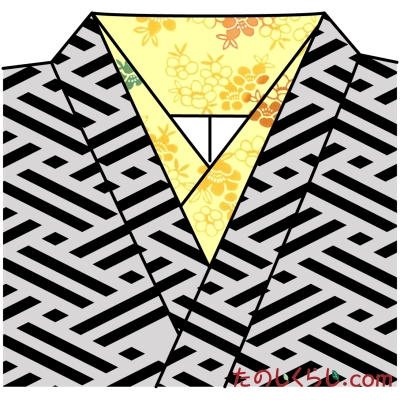 当時は、ガーゼや包帯などの役割から、現代のタオルや台拭や雑巾やハンカチなどの役割も担い、そのほかには縁起物としての贈答品や配り物としても使われ、本来の汗や水の吸水の目的だけでなく様々な用途の広がりをみせていきました。 ここでは、「手ぬぐいの使い方」として、現代での使い方をイラスト入りでご紹介していきます。 その四は "半衿" です! 手ぬぐいを縦に二つ折りか三つ折りにして、長襦袢の衿に縫い付けて半衿にすると、ちょうど良いサイズになります。綿素材なので肌触りも気持ちよく、お気軽に洗えます。 浴衣や小紋に合わせてもお洒落な "半衿" です(^^) In Japanese history, the tenugui (Japanese towel) was originally used approximately between 700s and 1100s A.D. (Nara & Heian era in Japan). At that time, the tenugui was only available for people of high social status, because cloth was a valuable item. After the late 1100s (during the Kamakura era), the tenugui gradually became available to commoners. In the 1600s, when cotton farming developed, the tenugui, as well as cotton fabric, became a common item for people in Japan. Since then, tenugui usage has expanded from as a simple towel to absorb liquid to as a gauze bandage and a gift and giveaway item. Below are some examples of how to use the tenugui during modern times (with illustrations): <4. As a han-eri (a detachable neckpiece for kimonos)> A tenugui folded (two or three times) horizontally along the longer side becomes a perfect size as a han-eri. The cotton feels soft to the skin and it does not require dry cleaning. |


